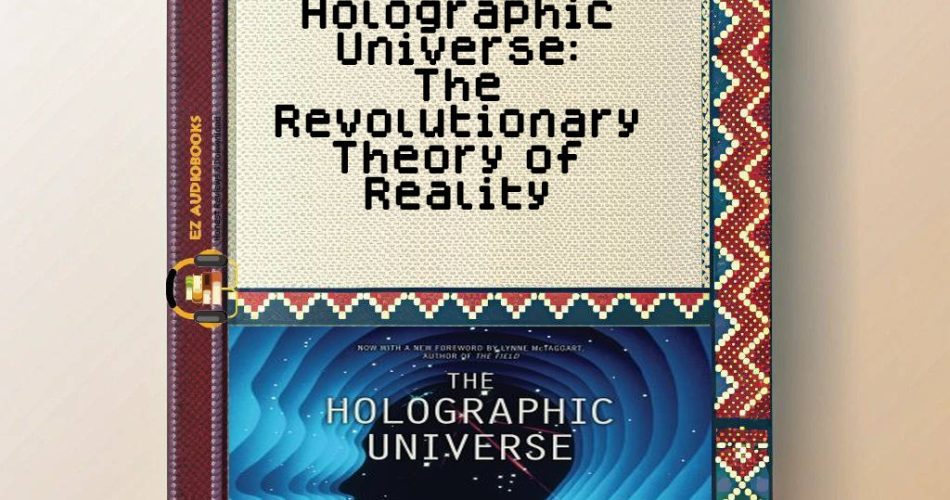Audiobook Sample
Listen to the sample to experience the story.
Please wait while we verify your browser...
- Title: Holographic Universe: The Revolutionary Theory of Reality
- Author: Michael Talbot
- Narrator: Nick Mondelli
- Length: 13:00:00
- Version: Abridged
- Release Date: 15/04/2021
- Publisher: Dreamscape Media, LLC
- Genre: Non-Fiction, Science & Technology, Astronomy & Physics, Philosophy
- ISBN13: 9.78E+12
Today, I’m thrilled to share my thoughts on the audiobook ‘Holographic Universe: The Revolutionary Theory of Reality’ by Michael Talbot, narrated by Nick Mondelli. As a literature professor with a deep fascination for cross-disciplinary narratives, I found myself immediately captivated by this work that bridges quantum physics, neurophysiology, and mystical experiences. What fascinates me most is how Talbot weaves a narrative that challenges our very perception of reality, suggesting the universe itself might be a giant hologram constructed, in part, by the human mind. This audiobook experience, available through Dreamscape Media, offers not just a scientific theory but a profound philosophical inquiry into the nature of existence.
Through a cultural lens, this book resonates with me on a personal level, reminding me of a moment during my time as a visiting professor in Tokyo. I was immersed in Haruki Murakami’s ‘Kafka on the Shore,’ exploring how language shapes narrative perception. Much like Murakami’s magical realism felt more intrinsic in Japanese, Talbot’s exploration of a holographic universe feels almost intuitive when paired with Eastern philosophies of interconnectedness. I recall late-night discussions with colleagues about the nature of reality – conversations that mirrored the questions Talbot raises about telepathy, near-death experiences, and cosmic unity. This audiobook rekindled those intellectual sparks, urging me to reconsider the boundaries of the physical and the metaphysical.
Delving into the content, Talbot draws upon the groundbreaking ideas of physicist David Bohm and neurophysiologist Karl Pribram to propose that the universe operates as a hologram – a construct where every part contains the whole. This theory not only addresses unsolved puzzles in physics but also offers explanations for phenomena often relegated to the mystical, such as lucid dreams and miraculous healings. As someone who has taught contemporary fiction and analyzed narrative structures, I appreciate how Talbot crafts these complex scientific and philosophical ideas into an accessible story. His ability to connect quantum mechanics with human experiences like out-of-body encounters is akin to a literary device, blending the empirical with the ethereal.
The audiobook experience is elevated significantly by Nick Mondelli’s narration. His voice carries a measured gravitas that suits the weighty subject matter of astronomy, physics, and philosophy. Mondelli navigates the dense scientific terminology with clarity, ensuring that even listeners unfamiliar with quantum theory can follow along. His pacing is deliberate, allowing the weight of each revolutionary idea to sink in, much like a professor pausing during a lecture to let a profound point resonate. The audio quality itself is crisp, with no distracting background noise, making for an immersive listening experience. Whether I was listening during my commute or late at night in my study, Mondelli’s narration transformed complex concepts into a meditative exploration of reality.
However, I must offer a balanced perspective. While the content is undeniably thought-provoking, there are moments where Talbot’s reliance on anecdotal evidence for phenomena like telepathy may leave more empirically minded listeners wanting. As an academic, I found myself wishing for more robust scientific backing in certain sections, though I appreciate that this work is meant to inspire wonder as much as to inform. Additionally, while Mondelli’s narration is generally excellent, there are instances where a touch more emotional inflection could have heightened the impact of the more mystical passages. These minor critiques aside, the audiobook remains a compelling entry point into non-fiction science and technology discussions.
Comparing ‘Holographic Universe’ to other works in the genre, I’m reminded of my Berkeley seminar on contemporary fiction where we explored how different mediums affect storytelling. Much like our analysis of ‘Cloud Atlas’ across formats, this audiobook stands out against similar texts in print. It shares thematic ground with works like ‘The Tao of Physics’ by Fritjof Capra, which also explores the intersection of science and mysticism, but Talbot’s focus on the holographic model offers a unique lens. For those intrigued by philosophy and physics, this audiobook experience provides a narrative depth that print might not fully capture, thanks to Mondelli’s interpretive delivery.
I recommend this audiobook to listeners who are intellectually curious about the mysteries of the universe, particularly those with an interest in non-fiction, science, and technology. It’s ideal for anyone who enjoys pondering big questions – whether you’re a student of physics, a philosopher at heart, or simply someone who wonders about the nature of reality. The audiobook format makes these complex ideas more digestible, perfect for long drives or quiet evenings of reflection. If you’re seeking a free audiobook to dive into these topics, check available platforms for promotional offers, as this listening experience is well worth exploring without cost.
Reflecting on my own journey with this book, I’m struck by how it mirrors my academic pursuits in digital humanities and storytelling. Just as I’ve examined how technology shapes narrative, Talbot’s theory suggests that our minds shape reality itself. This idea lingers with me, much like a powerful novel that reshapes your worldview long after the final chapter. It’s a reminder of why I’m drawn to narratives that push boundaries – whether in literature, science, or philosophy – and I’m grateful for this audiobook’s ability to bring such a mind-bending concept to life.
As I close this review, dear listeners, I encourage you to embark on your own exploration of ‘Holographic Universe.’ May it inspire the same sense of wonder and inquiry that has fueled my career in literature and beyond. Until our next intellectual adventure, this is Prof. Emily Chen, signing off with curiosity and gratitude.

